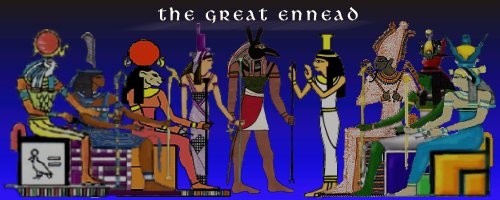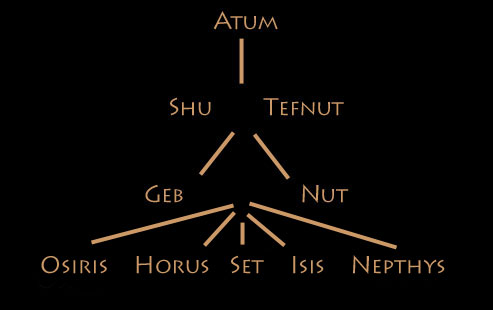
The Ennead
Heliopolis is found just to the northeast of modern Cairo. It was was politically and spiritually powerful during the Old Kingdom. It is the site of the first known sun temple, which was dedicated to Re-Hekarte. Today, only a single relic remains standing at the site. The obelisk of Senwosret I now marks the location.
According to the Heliopolitans, the first act of creation occurred when the sun god Atum, "lord of Heliopolis", rose out of the chaos of Nun from a lotus flower and stood on a raised mound he created, the ben-ben. This first act of creation brought light into the world. At the site of his emergence, the temple of Heliopolis was built. Atum was called a self-created god or the child of Nun. He was also said to be the ben-ben. At the time of the Pyramid Texts, Atum became identified with Re. As Atum-Re, he was connected to the Bennu bird (the phoenix).Atum created his children, Shu and Tefnut by masturbating. This may seem impossible but Atum was a bisexual god. He embodied both the male and female aspects of life. Therefore, his semen contained all that was necessary to create new life and deities. The Egyptians called Atum "Great He-She" and his name meant "the complete one".
Shu and Tefnut in turn conceived Geb and Nut through normal sexual relations. Geb was the god of the earth and Nut was the sky. After conceiving four children (Osiris, Isis, Nephthys, and Seth), Geb and Nut became separated by their father Shu, the god of the air. Nut is often shown arched over Geb with the sun traveling along her body. Beyond Nut's body lies Nun and nonexistence.

Gods and Goddesses
The ancient Egyptians lived in a world animated by forces over which he had little control. By naming them, giving them shape and character they attempted to find some understanding and ultimately ways to influence their behaviour.
The first deities were purely local. They were hoped to protect the village, to bring fertility to fields, livestock and people, to help in hours of need. They were their defenders against malicious spirits and evil demons, which brought about disease, infertility and natural calamities.
They were often given shapes which reflected their characteristics:
- Bulls were venerated for their power and fertility
- Falcons represented the sun wandering through the sky
- Hippos were known for their fierce defense of the young
- Lions and lionesses were admired for their fighting prowess
- Dung beetles emerged from the ground, apparently self-created
- Jackals were frequently observed near graveyards
Some gods were difficult to represent: darkness, moisture, air, hiddenness, creativity etc. These were often given human form.
Others were depicted as chimaera, ferocious monsters with body parts of various wild animals, e.g. Ammit, the devourer of the hearts of the sinners, who had a crocodile's head, a lion's forelegs and body and the hindparts of a hippopotamus. They were generally dangerous to mankind, and we often refer to them as daemons, though the Egyptians themselves did not make any such distinction. They played a minor role in religion and mythology, lacking characterization and often remaining nameless. Yet, knowledge of their names was crucial when a person wanted them to do his bidding or had to protect himelf from their attentions. Thus the Declarations of Innocence in the Book of the Dead, a guide book through the underworld, mentioned the names of the fourty two judges involved in the Judgment of the Dead, giving the deceased power over them.
The pantheon of the Egyptians was huge, comprising myriads of gods, demons and spirits, most of them of little consequence. A few gods achieved national standing, being worshiped in many places, some even crossed the seas and became important deities of foreign peoples: the cult of Isis, for instance, was widespread throughout the Roman empire. Others remained intimately personal, such as one's ancestors.
The ancient Egyptians never abandoned their multitude of gods in favour of one single deity. There was apparently a feeling that the sacred was a union of all the gods which also comprised the deceased humans, and as such was indivisible. Even Akhenaten who was involved in a struggle against the followers of Amen appears to have done little to discourage the worship of deities other than Amen.
The Egyptians had no difficulty in perceiving characteristics common to two or three gods and then uniting these gods into one deity, a process called syncretism. During the New Kingdom Amen, the hidden one, was joined to many gods, mainly on a local basis, but as Amen-Re he became–and remained for two millennia–the embodiment of creator and protector of The People, the Egyptians.
The Minor Gods
Aker
Symbol: Two lions, separated by the sun.
Purpose: Guardian of the corpse of Apep and the passage of the sun. Aker carries the sun-god?s boat on his back through the Underworld at night.
Power: Neutralizing venom.
Ammut
Symbol: Head of crocodile, body of lioness, and hind of hippopotamus.
Purpose: Eater of bad souls. If a person's soul outweighs the feather of Ma'at during judgement in the Hall of the Dead, Ammut devours it, condemning the soul to oblivion.
Power: Making souls cease to exist.
Anat
Symbol: Crown flanked with plumes; woman with battle axe and spear.
Purpose: Protector of Pharaoh in battle.
Power: Strengthening and protecting warriors, offensively.
Anhur
Symbol: Man with arms raised, crowned by four feathers; sometimes carrying a string with which he leads the sun.
Purpose: Warrior protector. He also was the one Ra sent to reconcile Hathor to himself.
Power: Protecting from enemies, defensively.
Anti
Symbol: Hawk-headed man on a crescent-shaped boat.
Purpose: Guardian of the sunrise. He helps the sun rise, beginning its journey on celestial waters in his boat.
Anubis
Symbol: Jackal-headed man; reclining black jackal.
Purpose: Patron of drugs and poison; Guardian of mummification; Patron of magic; Guide of the dead; Weigher of hearts in the Hall of Ma'at. Anubis also guards the souls from Ammut until his/her fate is decided.
Power: Foretelling destiny or death; assisting in magic and drugs.
Anuket
Symbol: Gazelle; woman wearing feathered headdress.
Purpose: Guardian of the Nile.
Apep
Symbol: Giant snake.
Purpose: Enemy of Ra. Every night he battled to swallow the boat of the sun god, but was always defeated eventually, and the sun was free to rise again. Isis defeated him for good by cutting him into pieces and giving the pieces to Aker to guard.
Power: Evil strength.
Atum
Symbol: Pharaoh wearing pshkhent and carrying the crux ansata; male cat.
Purpose: Evening aspect of Ra, the sun god.
Power: Omnipotent.
Aten
Symbol: Solar disk with rays ending in hands offering ankhs, or life.
Purpose: Creator; only true god.
Power: Omnipotent.
Babi
Symbol: Baboon.
Purpose: 'Phallus of heaven.' A fertility god, his phallus is reputed in varying myths to be the bolt on the doors of heaven, the mast of the ferryboat of the underworld, and important for a man to identify his own phallus with in order to secure potency in the Afterlife.
Power: Warding off snakes and storms; fertility.
Ba Neb Tetet
Symbol: Ram.
Purpose: Mediator of the gods.
Bastet
Symbol: Cat; cat-headed woman carrying a sistrum.
Purpose: Guardian of the home, love, sex, fertility, and the domestic cat; Protector of Pharaoh.
Power: Fertility; love; protection from enemies.
Benu
Symbol: Heron with two long head plumes.
Purpose: Visible aspect of Ra; symbol of rebirth.
Bes
Symbol: Ugly dwarf with a large heard and a long tail,, wearing a plumed crown and the pantherskin of a priest, carrying weapons and clanging instruments.
Purpose: Guardian against evil spirits; Guardian of childbirth and the family; Patron of entertainment.
Power: Protection from evil spirits; childbirth; fun.
Geb
Symbol: Goose; green ithyphallic man, sometimes with a goose on his head.
Purpose: Earth god. His laughter causes earthquakes, he controls the growth of vegetation. Some myths state that he ruled earth prior to Osiris' reign.
Power: Growth of vegetation; potency.
Hathor
Symbol: Cow; cow wearing stars; cow-headed woman; broad-faced, cow-eared woman wearing on her head cow horns which surround a solar disk and two feathers; papyrus reed; snake; sistrum.
Purpose: Mother of pharaohs -- Hathor is said to nurse the infant pharaohs, who draw both nourishment and divinity from her milk and become gods; Patron of music, dance, and merriment; Guardian of women and lovers.
Power: Motherhood; joy; womanhood; dance; music.
Symbol: Frog; frog-headed woman.
Purpose: Midwife of the sun during its daily birth.
Power: Midwifery; fertility.
Symbol: Falcon; Falcon-headed man; winged sun disk; falcon-headed lion.
Purpose: God of light; keeper of wisdom.
Power: Strength; victory in battle; wisdom.
Imhotep
Symbol: Seated man, clothed as a priest, with a papyrus roll open across his knees.
Purpose: God of knowledge and healing. Imhotep was an architect and a healer, so renowned that he was deified after his death. As son of Ptah, he had power to give children.
Power: Learning; healing; fertility.
Ishtar
Symbol: Eight-pointed star; voluptuous woman with quiver, bow, and sword; lioness.
Purpose: Warrior goddess; Patron of sexuality; Patron of healing.
Power: Sexuality; power in battle; healing.
Isis
Symbol: Woman crowned by a throne or vulture; kite; winged woman.
Purpose: Bringer of the Inundation; goddess of funeral rites; Patron of magic; Giver of the secrets of medicine; institutor of marriage.
Power: Magic; medicine; love; wind.
Khepri
Symbol: Scarab; man with a scarab for a head.
Purpose: Morning aspect of Ra, the sun god.
Power: Omnipotent